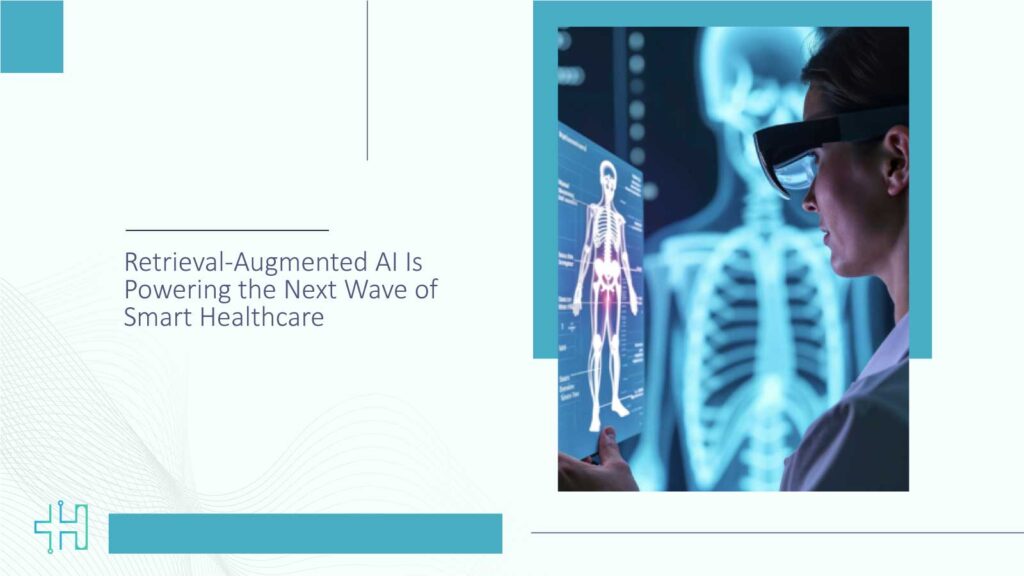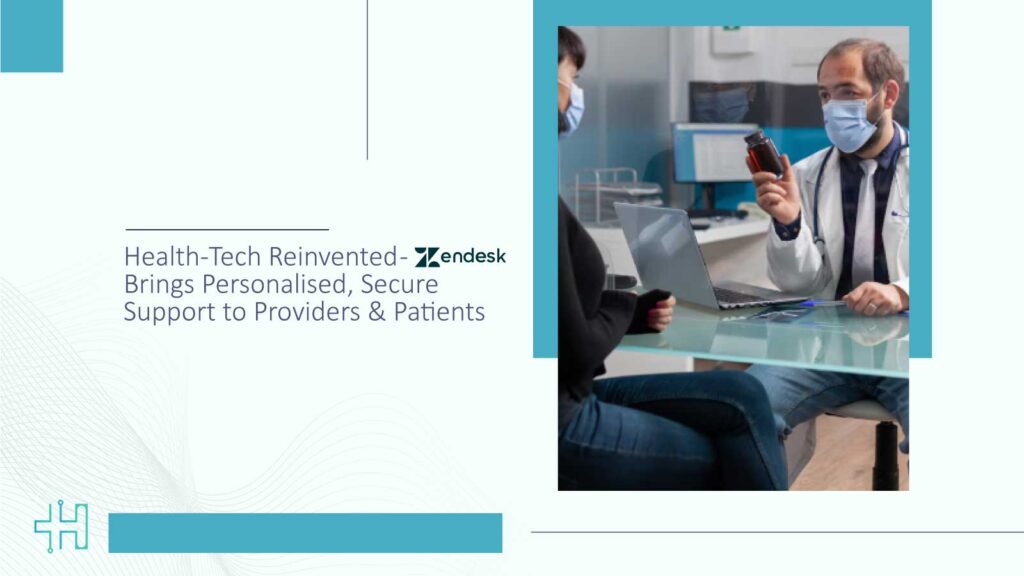Imagine an AI that doesn’t just generate answers, but actively knows where to look, what to retrieve, and why it matters. That’s the strategic power of retrieval‑augmented AI, the emerging force behind the next wave of smart healthcare. Unlike conventional large language models that rely solely on static training data, this next-gen approach connects AI systems to real-time clinical knowledge, from treatment guidelines and drug databases to peer-reviewed research and patient histories.
The result? Faster, more accurate, and more context-aware decisions, delivered when and where they’re needed most. Whether it’s surfacing the latest FDA-approved therapy, matching a patient to a clinical trial, or generating documentation that aligns with evolving compliance standards, retrieval‑augmented AI is already reshaping how care is delivered, data is interpreted, and outcomes are improved.
If you’re a healthtech leader, CIO, or clinical innovator looking to future-proof your operations, this is no longer an experiment. It’s an inflection point, and a smart, data-driven leap that the most forward-thinking organizations are embracing now.
How Retrieval-Augmented AI Really Works
Ultimately, retrieval-augmented AI is really all about memory enhancement for large language models. Rather than drawing on what they “learned” through training, RAG models actively query linked databases, clinical guidelines, trial registries, and patient records to construct real-time answers based on fact, not fiction.
Why should this concern you? In medicine, a generic response versus a clinically correct one can be literally life and death. A 2025 npj Health Systems study stressed that RAG systems cut down on hallucinations, those times when AI simply makes something up, and ramp up transparency by telling you exactly where the information was derived.
It’s akin to asking a doctor who immediately consults the latest clinical guidelines and your full patient chart before speaking.
2. Real-World Examples You Need to Know
So, what does retrieval‑augmented AI look like in action? It’s not living in labs anymore; it’s already being put to work across hospitals, research centers, and clinical workflows. From frontline diagnostics to backend decision support, here’s how it’s making a measurable difference right now.
Nephrology & Ophthalmology
When tested in ophthalmology, researchers tested a retrieval-augmented system at 84% alignment with expert decisions. Traditionally built models only managed half of that. In nephrology, it helps doctors follow current Chronic kidney disease (CKD) guidelines without missing a beat.
Clinical Trial Matching
Matching patients to clinical trials typically takes weeks. RAG reduces that by a huge margin by comparing patient information automatically with thousands of trial protocols, frequently bringing up matches clinicians won’t discover on their own.
Radiology Reports
A model augmented by RAG increased the accuracy of X-ray reports by 26% over GPT-3.5 alone. Less guessing. More clinically useful information.
Drug Discovery
At Oxford, scientists employed retrieval-augmented AI to find 54 gene targets in days, a task that once took whole teams weeks.
Patient-Facing Tools
Multilingual RAG-powered bots are already assisting patients with asthma, chronic pain, and follow-up. These tools learn actual medical histories and changing care plans, not merely scripts.
3. The Market Is Moving Fast
The retrieval-augmented AI market is expected to grow from $1.2 billion in 2024 to over $11 billion by 2030, with U.S. healthcare organizations leading the charge.
Big names like Amazon, Microsoft, and Palantir put serious resources behind RAG-backed solutions. Why? Because they see where the puck is heading, intelligent systems that understand clinical nuance, not just process text.
If you’re a healthtech company and still questioning whether or not to jump on board, you’re behind the times.
4. What Healthtech Leaders Gain
Here’s the short list of why retrieval-augmented AI is finding traction with CIOs, CMIOs, and chief strategy officers nationwide:
Quicker decisions: Real-time access to reliable, structured know-how.
Less work by hand: Automates chart review, documentation, and research scanning.
Compliant insights: All answers are traceable to their origin.
Scalable learning: AI gets smarter without constant retraining.
Personalization: Outputs tailored to individual patients, not populations.
In short? It’s efficient, scalable, and smart, like having your best team on-call 24/7.
5. Want to Try RAG? Here’s How to Start
If you’re ready to dip your toe in, here’s the practical roadmap:
House your data. RAG is no better than the data it can pull. Ensure your systems are clean, up-to-date, and interoperable.
Invest in intelligent infrastructure. Leverage vector databases such as FAISS or Pinecone for rapid, relevant retrievals.
Secure first. HIPAA and data ethics. Ensure your systems secure patient information and remain compliant.
Begin small. Examples such as prior auths, doc assistants, or clinical trial search robots are wonderful, low-risk beginnings.
Measure what matters. Monitor improvement in clinician time, accuracy, and patient satisfaction, not model performance alone.
6. What the Industry Is Saying
Trust is fueled by transparency: The strength of RAG is found in its capacity to link outputs to verifiable documents in regulated industries such as healthcare and pharmaceuticals. Benchmarking studies, for instance, demonstrate that retrieval-augmented systems improve traceability and confidence by providing a clear “middle ground” between inflexible rule-based systems and opaque generative models by connecting replies back to reliable sources.
Momentum for responsible AI: Grounding outputs in retrievable documents improves system stability and stakeholder trust, according to a recent Pure Storage article that highlights RAG’s role in delivering transparency and auditability to AI systems.
7. What’s Next and What to Watch For
While retrieval-augmented AI is breaking new ground, the trip isn’t complete yet:
- We still require universal standards by which RAG’s quality can be measured across specialties.
- Integration requires delicacy. RAG needs to slide into EHRs, not battle them.
- Cloud expenses are real. Finding a performance and affordability balance is essential.
- Bias remains a threat. Garbage in, garbage out. Curation is important.
But they are solvable. The tools are available. It’s now leadership and implementation.
Transforming Diagnostics and Delivery for the Next Era
Retrieval-augmented AI is revolutionizing the way we diagnose, document, and deliver care. It’s a jump from reactive systems to proactive intelligence, one that comprehends not only what to say but why it matters.
If you have the opportunity to write the next chapter in healthcare, whether from the boardroom, the command center, or the clinic, then this is your time. Begin with a targeted pilot, collaborate with ethical AI teams, and build towards a wiser future.
The technology is in place. The question is: Are you?
FAQs
Q1: Why is Retrieval-Angmented AI more trustworthy than other AI solutions?
It doesn’t guess, it references. RAG tools verify current sources, making their response more accurate and reliable.
Q2: Do I have to give my entire tech infrastructure a complete overhaul to implement RAG?
Not at all. Start with simple use cases such as clinical documentation or trial matching and scale up from there.
Q3: Is patient information still secure using RAG?
Yes, if it’s constructed on compliant infrastructure. Think HIPAA-safe cloud and secure retrieval pipelines.
Q4: Will RAG replace physicians or simply assist them?
It’s designed to assist. It provides providers with better context, quicker, but human decision-making remains in the driver’s seat.
Q5: What type of ROI can leadership anticipate early on?
Seek lower admin time, improved diagnostic insight, and greater confidence in AI systems, all quantifiable gains.
Dive deeper into the future of healthcare.
Keep reading on Health Technology Insights.
To participate in our interviews, please write to our HealthTech Media Room at sudipto@intentamplify.com




